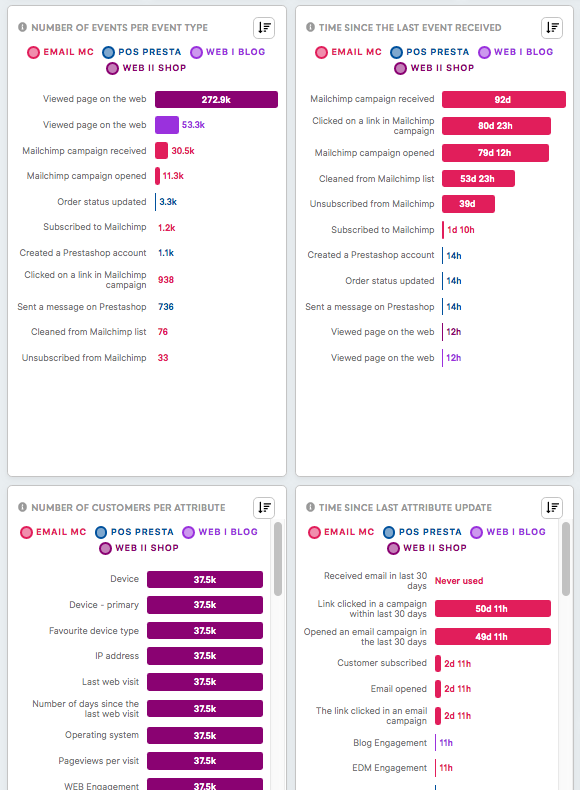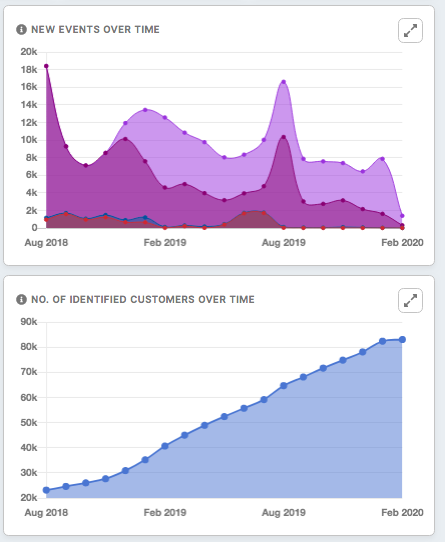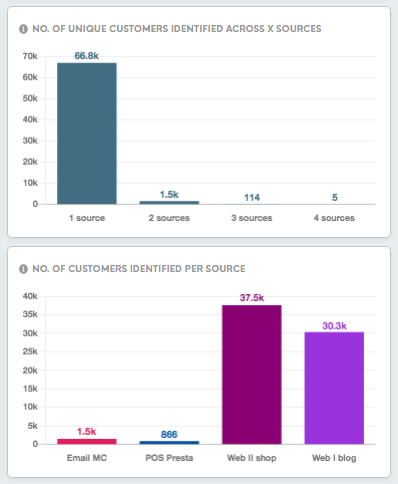Understand the bigger picture of your data
Diagnostic Dashboard
It is easy to get lost in the sea of data. The Data tab will help you to understand the bigger picture of your available data.
Look at the number of connected sources, customer attributes, customer attributes values, total events, identified customers, the average number of events per customer to get a bigger picture of the scale of your data. This information can help you to evaluate what size of data you are working with that has been extracted from your data sources, as well as how many data sources have been analysed.
The example above shows: 4 available data sources that have collected data for 76,300 customers profiles, 375,400 events, 86 attributes, in total giving 1.4 million attribute values. This gives an average of 5 events per customer.
The number of events per event type demonstrates how many actions customers performed, type of actions performed and on which platforms your customer is engaging the most with your brand.
In the example above we can see that the most popular is “Viewed a page on the web”.
The number of customers per attribute helps to evaluate the scale of the information about your customers across the data sources. In this way, you can evaluate what kind of data you can use to analyse, and determine which data source holds the highest amount of the information. You can evaluate the scale of the information about your customers across the data sources.
In the example above, we can see that for example device, IP address, last web visit are the most populated for the customers (37,500)
The time since the last event received shows how up to date events are.
The example above shows that the oldest event is "Mailchimp Campaign Received" and the youngest is "Viewed Page on the Web".
The time since last attribute update shows how up to date attributes are. This can help to spot some inaccuracies and monitor if data is updated on a regular basis.
In the given example, we can see that we have some attributes that have been never populated ("Received email in the last 30 days"), while the rest of the attributes have been updated from 50 days and 11 hours (for example, "Linked clicked in an email campaign within the last 30 days") to hours (for example "Blog Engagement").
The New Events Over Time and the Number of Identified Customers Over Time charts helps to highlight any dips and spikes in the number of customer events and identified customers. These number should broadly align to your customer engagement and acquisition strategy, we can expect a hike in number following a planned campaign.
In the case above visible peaks for a number of events (actions) are around August 2018 and 2019. We can also see that the number of identified customers overtime is increasing, while the number of events is currently decreasing.
he New Events Over Time and the Number of Identified Customers Over Time charts help to highlight any dips and spikes ni the number of customer events and identified customers. These number should broadly align to your customer engagement and acquisition strategy, we can expect a hike in number following a planned campaign.
The number of unique customers identified across x sources shows the number of customers that are identified on 1 through x sources. The higher the number of identified customers in the higher cross-data sources, the better the performance of the customer profiling process, and the better the quality of the customer profile output.
The chart above shows that the highest number of customers (66 800) is identified only in 1 source, while 1500 customers across 2 sources., 114 across 3 sources but only 5 though across all 4 sources.
The number of customers identified per source shows the data sources that hold the highest/lowest amount of customers. This can help to see which data sources are the most helpful for collecting the data about customers.
In the case above websites collect the highest amount of customers, while Prestashop the lowest.
Insights tab
Learn:Learn more: To learn what is possible with insight, please go to this article.




